How Data Makes us Healthier

When people think big data, certain industries come to mind. Government, retail, health care and financial services top the list of enterprises collecting and capitalizing on customer data.
But as personalization and omnichannel have become more of an expectation across all markets, new industries have started using customer data with the goal of improving a consumer’s experience.
One industry in particular stands out because of recent data collection and management advances. Through smartphone apps and fitness gadgets, the health and wellness industry is using data to revamp and refuel sales.
Why should we care what the health industry does?
The health and wellness industry holds high status in the marketplace. With Nike named the top brand for the largest purchasing power, we can expect Nike and other wellness enterprises to stay relevant in the market by incorporating the latest technology into marketing strategy. Based off these innovations, companies in any industry can get inspired by these groundbreaking new ways to use data.
So how is the health and wellness industry using customer data?

Smartphone Apps
Smartphone apps that focus on health have been around for years. These apps were the original building blocks for exposing health and fitness to data. Because of their initial influence, apps have a key role in the health industry’s data interest.
The most popular smartphone health apps come in the form of tracking and managing workouts. Smartphone apps like Nike+ Running record and store data from a workout. The app measures various elements of a workout, including distance covered, calories burned, average pace, and duration of workout.
These are successful because they let users access and manage their data easily. A major motivator for fitness gurus is tracking and viewing progress, which can be easily done through a simple download on a smartphone.
And some apps offer more than just tracking data. Nike+ Running can sync to social media accounts and notify Facebook friends about big accomplishments, like longest run or fastest pace. With this multi-channel development, smartphone apps are getting praise across a variety of platforms.
Fitness wearables
 Smartphone apps typically only collect data during a workout. However, technological advances are helping fitness fanatics track their health 24/7.
Smartphone apps typically only collect data during a workout. However, technological advances are helping fitness fanatics track their health 24/7.
Wearable devices help consumers manage their health with an in-depth, convenient approach. They come in different varieties and forms – from the Fitbit to watches to diamond crested accessories. These fitness devices measure specific elements of health, such as steps counted or hours slept. The device then processes the information into a consumer’s personal profile, which the consumer can manage at his or her leisure.
In today’s market, there is no doubt about the potential for these fitness appliances. The only debate in this arena is over which wearable is best.
With the ability to constantly track activity, sleep, heart rate, calories and location, fitness wearables are convenient and easy answer to a healthier lifestyle.
Specialized omnichannel gadgets
Data usage is not limited to fitness tech – personal hygiene is using consumer data as well.
Personal hygiene may seem like an unlikely candidate for data usage. However, the dental industry is starting to focus on personalization and omnichannel, placing a need for customer data.

In a recent AdAge article, writer Kate Kaye explores an innovation that is redefining dental hygiene. Beam Brush is a toothbrush-inspired enterprise. It connects its users to a network of 95,000 dentists and discounts based on points awarded after using the brush. Users track their teeth cleaning activity and are rewarded with loyalty programs. All activity is synchronized to a user profile in a mobile device.
Despite its ties to teeth, Beam Brush emphasizes that it is not a toothbrush company. Instead, Beam Brush is more invested in collecting health data.
Beam Technologies founder and CEO Alex Frommeyer reportedly said, “If we know there are a million people in Beam’s ecosystem and we know what behavioral triggers we tend to see with high rates of gum disease, then that insight can be translated to a dentist when we see those triggers hit.”
This insight Frommeyer references can prevent dental damage and increase loyalty programs. This is extremely powerful for companies, as an increase in loyalty likely results in improved ROI.
Takeaways
Besides getting inspired from learning about the latest and greatest ways that unlikely vendors are using data, there are some key things marketers should recognize from these recent advancements.
First, it’s important to recognize that if one unlikely (but large) industry is using customer data, several others are sure to follow. This means that more businesses will utilize customer data. With more entities capitalizing on data, consumers will likely be pressed to share more personal info. With more data readily available, marketers should consider the potential for third-party data integration.
Another important takeaway is to acknowledge how willingly these users share personal data with these devices. The reason some users are letting their movements be tracked 24/7 (read: FitBit) is because they feel safe and secure in their data protection. Marketers should realize that, when customers feel like their data will be safely guarded, they will share more.
The final takeaway is that that there is so much more opportunity for customer data usage. With this notable amount of data integration in a short span of time, marketers must anticipate and prepare for upcoming technology innovations and trends. Marketers should stay informed via tech news outlets, to ensure they don’t get left behind in data usage.






